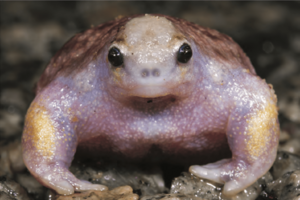Turtle frog facts for kids
Quick facts for kids Turtle frog |
|
|---|---|
 |
|
| Conservation status | |
| Scientific classification | |
 |
|
| Range of turtle frog |
The turtle frog (scientific name: Myobatrachus gouldii) is a special type of frog that lives only in Western Australia. It's the only species in its group, called Myobatrachus. This frog gets its name because it looks a bit like a turtle without its shell!
Turtle frogs have a very small, narrow head. They also have short legs and a round body. These unique frogs can grow to be about 45 millimetres (1.8 in) long. They have very strong chest bones for their size. Scientists think their unusual body shape comes from very old frog families that lived a long, long time ago.
Where Turtle Frogs Live
You can find the turtle frog in a specific area of Southwestern Australia. This area is between Geraldton and the Fitzgerald River, near the city of Perth. The land here is mostly dry, like a desert, so these frogs have learned to live only in this special environment. They haven't been found anywhere else in the world.
Even though they live in just one small part of the world, turtle frogs are not currently in danger of disappearing. Scientists say they are of "least concern" for becoming endangered. Like many frogs, the turtle frog comes out of the ground when it rains or storms.
How They Dig and Eat
Turtle frogs have short, strong legs that help them dig into the sand. But unlike most frogs, they dig forward, just like a turtle! This is very helpful because they eat termites. Their strong legs and chest bones help them break into termite mounds to find food.
These frogs do not need to live near ponds or puddles of water. This is because their babies grow completely inside their eggs. This means they skip the tadpole stage! When they hatch, they are already fully formed little frogs. Only a few other types of frogs have this unusual life cycle. Some of their closest relatives are sandhill frogs and forest toadlets.
Reproduction
The mating process for turtle frogs starts when the male frog makes calls. They usually call and find a mate in the late spring. Once a male and female turtle frog choose each other, they go deep into their burrow. They stay underground together throughout the summer.
The female frog lays her eggs later, in late summer or early autumn. Their burrows can be quite deep, sometimes as much as 1.3 meters (about 4 feet) down! The eggs develop inside the burrow over several months. A female can lay up to 50 eggs, and each egg is about 7.5 millimeters (0.30 inches) wide. The baby frogs grow directly inside the egg until they are ready to hatch as tiny frogs.
Frog Family Connections
Scientists have studied the special proteins in the blood of frogs from the Arenophryne and Myobatrachus groups. These proteins show that these two types of frogs have unique body features. This suggests they share a common ancestor, meaning they came from the same frog family tree a very long time ago.
Their shared ancestor might have lived during the Miocene or Pliocene periods. These were times millions of years ago. Myobatrachus and Arenophryne are more closely related to each other than they are to other frogs like Metacrinia and Pseudophryne.



